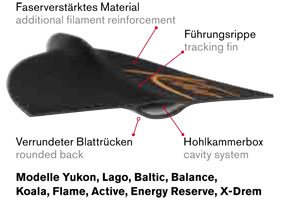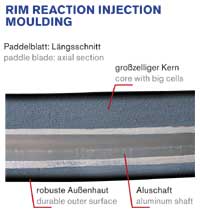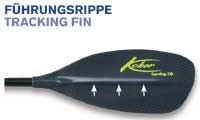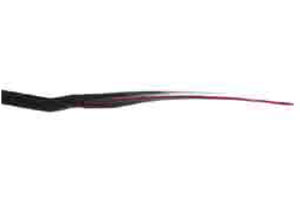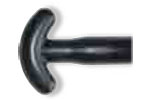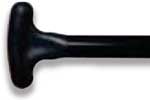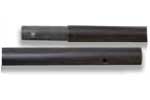Materialinfo
In the last years paddle sports has considerably changed and varied. New disciplines have come up such as Park and Play, Boater Cross or Stand Up Paddling, and also materials and technologies have been advanced and improved.
We at Kober & Moll have taken the chance and have designed the right paddle for any different use. That’s why of many models there are special versions for ladies , teenagers and kids
, teenagers and kids . The pictograms at the respective product indicate availability.
. The pictograms at the respective product indicate availability.
As different as the purposes are, one thing is common to all paddles: They need to be good! In the case of paddles this means to exactly meet expectations and use.
This is what a canoeist expects from a good paddle:
• Pleasant weight, well balanced
• Good performance in the water (silent, calm run, precise tracking, little sticking water at release) due to perfect hydrodynamic design
• Supports effortless paddling by high efficiency
• Anti-fatigue by ergonomic features and a flexible shaft
• Sturdy construction, long life
• Good price-to-value ratio
• Supports canoeists in their action and promotes paddling fun
The TechInfo explains, what crucial details are part of it, what sophistication our paddles contain and why a high performance paddle not necessarily is the first choice for a paddling novice.
Technologies I Constructions I Materials
Being pioneers in this production technology with its cavity-system, we have known and appreciated the advantages for a long time:
- Low weight (up to 25% lighter), thin blades, so less power is needed. Lightweight blades generate less centrifugal force and leverage, so paddles can be moved with less effort.
- Materials are used specifically for the required applications.
- Additional filament reinforcement.
- Equally spread cooling during production process = no hidden cracks.
- Tensionless blades – no warping = perfect performance.
Thanks to ATT-cavity-system the paddle blades can be designed with a thin, hydrodynamically optimized cross section leading to gentle performance and needing less power. The back of the blade doesn’t need any reinforcing ribs which would impair its performance:
- Whirlpools created at the backside of the blade would lead to a turbulent stroke.
- Catch and release of the blade would be influenced negatively by water sticking to the blade.
- Water sticking to the blade at the release couldn’t drain quickly enough and would add additional weight to the blade at each stroke.
This is why paddles by Kober & Moll don´t have those impairing ribs.
Materials used in ATT process:
- Polypropylene (PP)
As with all plastics, the quality of PP is very much dependent on the price. Kober & Moll use only high quality PP to achieve highest strength, low weight and high performance. We prefer PP for touring paddles due to its perfect weight-to-strength ratio. The mechanical properties are influenced positively by the addition of filaments. - Polyamide (PA)
As with PP, the quality of this raw material depends directly on the price. At Kober we use only the best PA available (yes, the one with the highest impact resistance) for our high quality WW-paddles. They are additionally reinforced with filaments (carbon or glass), resulting in stiff, heavy-duty blades which are also extremely impact resistant, abrasion resistant and durable.
Im ATT-Verfahren verarbeitete Materialien:
Paddle Technique

High angle style, mostly used by highly skilled paddlers, is the more active style. The blade moves close to the boat, your pushing hand moves above shoulder level. This technique is more efficient as the boat drifts off track only slightly at each stroke. The blades used are short and wide. The paddle length is a bit shorter, too.
Paddle Shafts

All aluminium shafts processed at Kober & Moll are seawater resistant. Varying according to use, we are offering three different types:
· Touring and easy WW, Ø 30 mm, anodized
· Kids’ paddles with a smaller diameter, Ø 28 mm
· WW and polo, heavy duty shaft, Ø 30 mm, anodized
Grip areas are covered with insulating shrink tube and are oval-shaped to improve ergonomics, varying according to use.
Especially for small hands we offer some models with a smaller shaft diameter (Grizzly, Little Bär, Rafting, Trophy, Economy). So the hands can held the shaft more safely.
Canoe Paddle Handles
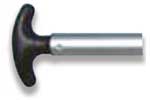
Adapted to the hand’s shape. Provides exact control of the paddle and makes manoeuvring easier. Preferred in swift waters.
Models: Stand Up, Leader, Pioneer, Contra, Little Bär, Traveller, Dragon Training
Splitting Systems
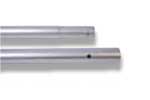
For aluminium shafts. Works like tent poles and is locked by a spring button. 60° right and left feathered.







